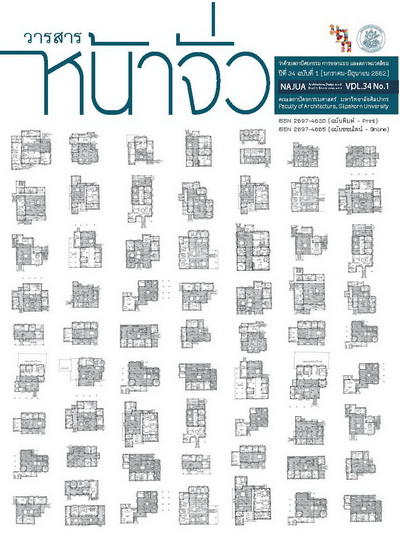ความหมายเชิงสัญลักษณ์และวัฒนธรรมของภาพเครื่องเรือนจีน สมัยรัตนโกสินทร์ตอนต้น รัชกาลที่ ๓ ในจิตรกรรมวัดราชโอรสารามฯ
คำสำคัญ:
จิตรกรรมฝาผนัง, วัดราชโอรสาราม, พระบาทสมเด็จพระนั่งเกล้าเจ้าอยู่หัว, อิทธิพลวัฒนธรรมแบบจีนบทคัดย่อ
ความหมายเชิงสัญลักษณ์และวัฒนธรรมของภาพเครื่องเรือนจีน สมัยรัตนโกสินทร์ตอนต้น รัชกาลที่ ๓ ในจิตรกรรมวัดราชโอรสารามฯ
กิตติคุณ จันทร์แย้ม
ภาควิชาประวัติศาสตร์ศิลปะและโบราณคดี วิทยาลัยบูรพคดีศึกษาและการศึกษาแอฟริกา มหาวิทยาลัยลอนดอน
งานวิจัยนี้วิเคราะห์งานพุทธศิลป์ เพื่อสังเคราะห์พฤติกรรมการปรับตัวทางวัฒนธรรมของมนุษย์ในอดีตในช่วงพุทธศตวรรษที่ ๒๔ ด้วยการศึกษาผ่านแนวคิดและวิธีการศึกษาแบบสหวิทยาการประกอบด้วย แนวคิดประวัติศาสตร์ศิลปะ (การศึกษาเปรียบเทียบ) แนวคิดมนุษยนิเวศวิทยาในโบราณคดีสิ่งแวดล้อม และแนวคิดปรากฏการณ์วิทยาทางภูมิทัศน์ ผลการศึกษาพบว่า ภาพจิตรกรรมเครื่องเรือนจีนภายในพระอุโบสถวัดราชโอรสารามฯ แสดงถึงการเปลี่ยนแปลงวัฒนธรรมแบบระยะสั้นผ่านกระบวนการคัดเลือกทางวัฒนธรรมที่หลากหลายในสังคมสยาม
นอกจากนี้ผลจากการสังเคราะห์ข้อมูลด้วยมุมมองจากแนวคิดที่หลากหลายดังกล่าว ยังช่วยให้งานวิจัยนี้ค้นพบประเด็นปรากฏการณ์การเปลี่ยนแปลงทางวัฒนธรรม ประกอบด้วย อำนาจของภาพ ฐานานุศักดิ์ในงานศิลปะ บทบาทของภาพจิตรกรรม และปฏิสัมพันธ์ของมนุษย์กับสิ่งแวดล้อมทางวัฒนธรรม ซึ่งเผยให้เห็นพลวัตของการปรับตัวทางวัฒนธรรมได้อย่างเป็นระบบที่ชาวสยามตอบสนองต่อการเปลี่ยนแปลงทางวัฒนธรรม โดยพบว่า การเปลี่ยนแปลงทางวัฒนธรรมดังกล่าวเป็นผลจากการปรับตัวทางวัฒนธรรมที่ชนชั้นสูงชาวสยามตอบสนองต่ออิทธิพลทางความคิดและรูปแบบทางศิลปะของจีน สืบเนื่องมาจาก “พระราชนิยม” ในรัชกาลที่ ๓ ซึ่งสามารถระบุได้จากพระราชอำนาจของพระบาทสมเด็จพระนั่งเกล้าเจ้าอยู่หัว ผู้ทรงเลื่อมใสในพระพุทธศาสนาเป็นอย่างมาก และพระราชนิยมส่วนพระองค์ในวัฒนธรรมแบบจีน จึงพบว่า องค์ประกอบทางวัฒนธรรมแบบจีนหลากหลาย เช่น ภาพจิตรกรรมเครื่องเรือนจีนและรูปแบบอาคารอย่างเก๋งจีนนั้น ถูกนำมาปรับใช้ในการสร้างสรรค์วัดหลวงแห่งต่าง ๆ ที่ได้รับการอุปถัมภ์จากสถาบันพระมหากษัตริย์และชนชั้นสูงในแผ่นดินรัชกาลที่ ๓
References
- Achirat Chaiyapotpanit. (2013). King Rama III-Period Murals and their Chinese Home Decoration Theme. Journal of the Siam Society, 101, 35-48.
- Baker, Chris and Phongpaichit, Pasuk. (2009). A history of Thailand. Cambridge: Cambridge University Press.
- Baker, Chris and Phongpaichit, Pasuk. (2017). A history of Ayutthaya: Siam in the early modern world. Cambridge: Cambridge University Press.
- Beurdeley, Michel. (1979). Chinese furniture. Tokyo; New York: Kodansha International.
- Bunjopporn Prapattong. (2004). Kan sueksa priabtiab phap chittakam faphanang phap khruengto bucha khong wat nai khet Krungthep Mahanakhon (In Thai) [A Comparative Study of Chinese Ritual Altar Mural Paintings in Temples Around Bangkok]. Master of Art in Art Education, Srinakharinwirot University.
- Burney, Henry. (1911). The Burney Papers. Vol. II. Bangkok: The Vajirayana National Library.
- Butzer, Karl. (1982). Archaeology as Human Ecology: Method and Theory for a Contextual Approach. Cambridge: Cambridge University Press.
- Chambers, William. (1968). Designs of Chinese buildings, furniture, dresses, machines, and utensils. New York: Benjamin Blom.
- Damrong Rajanubhab, Prince. (1917). Tamnan rueang khruengto lae thuai pan. (In Thai) [History of table decorative objects and porcelains]. Bangkok: Thai Beamseng.
- Damrong Rajanubhab, Prince. (1962). Phraratchaphongsawadan krung Rattanakosin ratchakan thi song. (In Thai) [Royal chronicles of the Bangkok in the reign of King Rama II. Vol.2]. Bangkok: Khurusapha.
- Freedberg, David. (1989). The power of images: Studies in the history and theory of response. Chicago; London: University of Chicago Press.
- Heidegger, Martin. (1993). Building dwelling thinking. D. Krell. (Ed). Basic Writings: From Being and time (1927) to the task of thinking (1964). San Francisco: Harper San Francisco.
- Jessica Lee, Patterson. (2016). Chinese Glass Paintings in Bangkok Monasteries, Project MUSE, 66(2), 153-185.
- Jiaqing, Tian. (1996). Classic Chinese furniture of the Qing Dynasty. London: Philip Wilson.
- Jiaqing, Tian. (2004). Early Qing Furniture in a Set of Qing Dynasty Court Paintings Chinese furniture: Selected articles from Orientations 1984-2003. Hong Kong: Orientations Magazine.
- Khanakammakan Chamra Prawattisat Thai, Samnak Lekhathikan Nayokratthamontri [The Committee for the Revision of Thai History, Secretariat of the Prime Minister]. (1982). Prawatsat Krung Rattanakosin ratchakan thi Nueng thueng Sam. (In Thai). [A history of Rattanakosin from the First Reign to the Third Reign Vol.1]. Bangkok: Khanakammakan Chat Ngan Somphot Krung Rattanakosin 200 Pi.
- Khaisang Sukhavadhana. (1982). Wat Putthasatsana ti dai rap itthipon silpa chin nai samai ton krung Rattanakosin. (In Thai). [The Chinese-influenced Thai Buddhist monasteries of the early Rattanakosin period]. Bangkok: James Thompson Foundation.
- Kirch, Patrick. (1980). The Archaeological Study of Adaptation: Theoretical and Methodological Issues, Advances in Archaeological Method and Theory. 3, 101-156.
- Lo, Andrew et al. (2011). Da Ying tu shu guan te cang Zhongguo Qing dai wai xiao hua jing hua. (In English). [Chinese Export Paintings of the Qing Period in The British Library]. Guangzhou: Guangdong ren min chu ban she.
- Manop Boonyavatana. (1988). The Grand Palace. Bangkok: The office of His Majesty's Principal Private Secretary.
- Merleau-Ponty, Maurice. (1962). Phenomenology of Perception. London: Routledge.
- O'Connor, T. P., & Evans, J. G. (2005). Environmental archaeology: Principles and methods (2nd, revised and updated ed.). Stroud: Sutton.
- Prayoon Uluchata. (1982). Nangsue Chut Krung Thep Song Sattawat: Chittrakam Samai Rattanakosin. (In Thai). [Collected books of 200th anniversary of Bangkok: the murals in Rattanakosin]. Bangkok: Muang Boran.
- Sakchai Saising. (2008). Ngan chang samai Phra Nangklao. (In Thai). [The creation in the reign of King Nangklao]. Bangkok: Matichon.
- Samerchai Poolsuwan. (1996). Sanyalak nai ngan chittakam Thai rawang phuttha sattawat thi 19-24. (In Thai). [Symbols in Thai murals between the 14th-19th century]. Bangkok: Thammasat University Press.
- Santi Leksukhum. (2001). Temples of gold: Seven centuries of Thai Buddhist paintings. London: Thames and Hudson.
- Santi Leksukhum. (2005). Chittakam Thai samai Ratchakan thi 3: Khwamkhit plian kan sadaeng ok ko plian tam. (In Thai). [Murals in the Third Reign: the expression changed by perspectives]. Bangkok: Muang Boran.
- Naengnoi Suksri et al. (1988). Sathapattayakam Phra Borom Maharatchawang. (In Thai). [The architecture of the grand palace]. Bangkok: The office of His Majesty’s Principal Private Secretary.
- Naengnoi Suksri and Michael Freeman. (1996). Palaces of Bangkok: Royal residences of the Chakri dynasty. London: Thames and Hudson.
- Nidhi Eoseewong et al. (2005). Pen and sail: Literature and history in early Bangkok including the history of Bangkok in the chronicles of Ayutthaya. Chiang Mai: Silkworm Books.
- Thiphakornrawong, Chaophraya. (1963). Phraratcha phongsawadan krung Rattanakosin ratchakan thi Sam. (In Thai). [Royal chronicles of the Bangkok in the reign of King Rama III]. Bangkok: Klangwittaya.
- Tiffany, Osmond. (1849). The Canton Chinese: or, The American's sojourn in the Celestial empire. Boston: J. Munroe and company.
- Tilley, Christopher. (1994). A phenomenology of landscape: Places, paths, and monuments. Oxford: Berg.
- Usawadee Rasmeewong. (1984). Phap chittakam khrueng bucha yang chin nai silpa Rattanakosin. (In Thai). [The theme of the Chinese altar style in Rattanakosin murals]. Bachelor of Art in Art History, Silpakorn University.
- Vella, Walter. (1957). Siam under Rama III. N.Y.: Association for Asian Studies.
- Wang, Shixiang. (1990). Connoisseurship of Chinese furniture: Ming and early Qing dynasties. Vol.1. Chicago: Art Media Resources.
- Wilairat Yongrot. (1996). Phap khrueng tang chittakam phutthabucha nai samai ratchakan thi sam. (In English and Thai). [Chinese auspicious in Thai murals]. Muang Boran, 22(3), 81-88.
- Williams, Chamber. (1976). Outlines of Chinese symbolism and art motives: An alphabetical compendium of antique legends and beliefs, as reflected in the manners and customs of the Chinese. New York: Dover.




